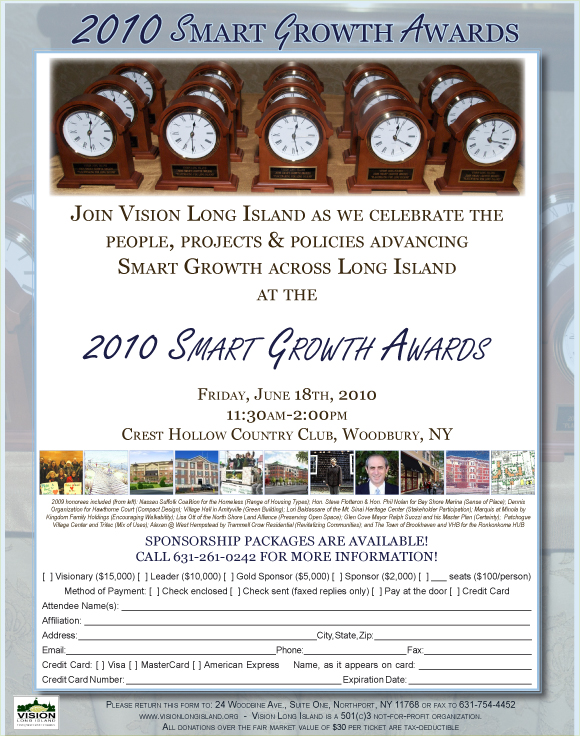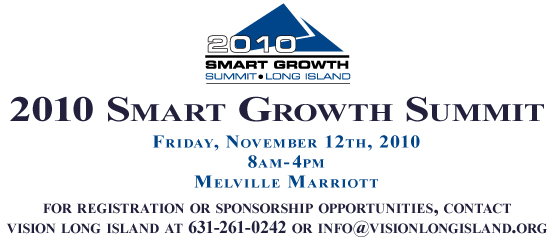Press Release - for immediate release: Contact:
Eric Alexander: www.visionlongisland.org 850 Long Island Leaders work together Record turnout, Governor Paterson,
A report outlining 95 Town and Village small, medium and large scale Smart Growth projects, 44 master, hamlet, corridor and vision plans and hundreds of supportive policies was released to the local municipalities for review. Vision Long Island will present the reports findings within the next six weeks. Attached is a preliminary review of the Summit sessions. Video of each of the workshops and transcripts of the plenary will be available in the coming weeks. Lastly, we want to thank everyone who made this event a huge success- sponsors, speakers, Board members, staff, and volunteers. There are many challenges ahead but, for at least one day, Long Island leaders worked together collaboratively to address ongoing issues, share successes, and troubleshoot challenges.
Vision Long Island’s 8th annual Smart Growth Summit, the premier land use conference in the region, was the biggest yet with nearly 850 attendees on Friday, November 20, 2009 at the Melville Marriott. Attendees included elected officials, chambers of commerce, civic leaders, developers, architects, planners, not-for-profits, concerned citizens, and more. This year’s theme, “regional challenges and local solutions,” focused on the ways in which large scale issues can be solved by looking at the work being done at the ground level in smaller municipalities. The Summit is a timely reminder that in this poor economic climate, Long Island must address the necessity for local, pedestrian friendly “Smart Growth” initiatives to serve as near-term and long-term economic generators for our community. The Summit included a breakfast, luncheon, and 14 workshops to choose from throughout the day. The 14 workshops included: Future of Media & Land Use, Tapping into the “New” Market: How Downtown Revitalization can keep our youth, attract boomers, and lower taxes, Suburban Revitalization (two sessions), Regional & Local Energy Solutions, Regional Planning: How All the Pieces Fit, Transit-Oriented Development, Developments of Regional Impact, NYS, Stimulus & Infrastructure, Emerging Industries: The New Job Market, Regulatory Toolbox: SEQRA, PDDs, Overlay Zones & TDRs, Green Building: Opportunities for LEED ND, Working With Long Island Communities, and How to Finance Smart Growth. STATE OF THE TOWNS & VILLAGES
Each official gave an update on Smart Growth progress and policies in their community over the past year. Panelists discussed future plans and outlined the challenges and support that is needed to implement Smart Growth for their municipalities. Joye Brown, Newsday columnist, moderated the session with a goal towards marrying regional initiatives with community needs. Mark Lesko noted that most Smart Growth projects involve density, which is often perceived as burdening school districts and raising taxes. If you’re not a property tax fighter on Long Island, you’re not going to be an elected official for very long! There is a need to delink Smart Growth from a tax burden association. When asked how to get taxes down, Jack Martins responded that one 9-story building in Mineola will be 7% of the village tax base. If you don’t build vertically where it makes sense, then you’re going to be stagnant and taxes will skyrocket.
Key themes that arose included the need for civics to push for projects, encouraging elected officials to understand the issues and provide leadership while really listening to a community’s input. FUTURE OF MEDIA & LAND USE
TAPPING INTO THE “NEW” MARKET: HOW DOWNTOWN REVITALIZATION CAN KEEP OUR YOUTH, ATTRACT BOOMERS, AND LOWER TAXES
SUBURBAN REVITALIZATION I & II Suburban development on Long Island takes two primary forms. First is the traditional neighborhood design of downtown centers. These neighborhoods are easily walkable, which is a product of compact building design with a mix of uses. Some are centered around mass transit, which contributes to promoting sidewalk activity over cars. There is a predominance of small businesses, and combined with a high concentration of activity, there is a solid economic base. The visual opposite of this type of development is what we know as suburban sprawl. Roads designed for speed, rather than for community, have led way to extremely unwalkable land uses. These strip corridors are marked by big box stores with huge parking lots in the front, high speed limits, several driving lanes, and few people walking. Uses are separated, with houses tucked back on side roads, isolated office complexes, and shopping malls. Suburban revitalization looks at both of these development patterns. Each type has its own design challenges and opportunities. As we continue revitalization efforts on Long Island, we want to enhance our existing downtowns to allow for more growth, and retrofit our commercial corridors to calm traffic and embrace placemaking. These two workshop sessions reviewed some of the recent best practices of small and medium sized suburban revitalization projects on Long Island.
REGIONAL & LOCAL ENERGY SOLUTIONS
Neal Lewis of the Sustainability Institute at Molloy College reminded attendees of the major climate issues taking place worldwide. There needs to be a series of solutions including efficiency, wind, and solar. Policy has much to do with alternative energy solutions and it is important that government on all levels takes proper steps to lead the way and achieve energy solutions. John Keating mentioned that his company, National Grid, wants to be a leader in the field and is looking to take dramatic steps by working with state leaders to lay foundation for energy change as well as challenging customers to reduce energy by 3%, which is not a lot to ask from customers but will make a big difference in energy consumption. Todd Stebbins of LIPA brought up that while the economy is dipping, so is energy consumption. When the economy recovers, LIPA is trying to make sure that energy consumption remains low. Rebates, incentives, and tax opportunities can help. Sharon Laudisi of NYPA faces many problems and issues involving energy efficiency. There needs to be efficiency components within the state to help positively impact our region. There is so much to be done with green jobs, and the existing workforce must be trained to provide green services. Working with local officials to make changes is key to help lead the way towards energy efficiency. David Hamilton’s company, EmPower, provides commercial and residential solar. Residential solar is doing very well on Long Island, thanks to rebates provided by LIPA. The next step in solar is the commercial sector. New technologies are emerging including net and car ports. REGIONAL PLANNING: HOW ALL THE PIECES FIT
David Calone of the Suffolk County Planning Commission said that growth needs to get done by communicating to all the players and between all the players. Jeff Greenfield of the Nassau County Planning Commission said that Long Island has a way of slowing down even those plans which have great support, so getting planners and community members to work to expedite projects is important. Michael White of the LI Regional Planning Council discussed the consensus building activities of the Long Island 2035 plan, which engaged municipal leaders and other stakeholders. He also questioned whether all these regional plans actually fit together, which led to some good discussion. Gerry Bogacz of NYMTC discussed some examples of projects that can come from regional plans, as well as projects that support the goals of regional plans. Moderator Richard Bivone helped to lead some great discussion about finding innovative ways to invest in ourselves. He proposed that the Nassau and Suffolk Planning Commissions hold a joint meeting to discuss planning activities in January. TRANSIT-ORIENTED DEVELOPMENT
This workshop explored the multitude of current transportation trends and opportunities on Long Island. Kate Slevin of Tri-State Transportation Campaign mentioned that the demand for housing has shifted: we now see a high demand for walkable communities. MTA’s Bob Paley said that the MTA wants to play a role in finding solutions, for example, taking a role in sustainability by mixing transit issues with real estate planning. Paley wants to coordinate land use with localities and state, federal, and regional entities. Geoffrey Morrison-Logan of VHB presented the Ronkonkoma Hub Transit Oriented Planning Study Overview as an example with community involvement, saying that visionings are essential. Maurice Fox of the Dennis Organization said that Long Island’s challenge is to create sustainable housing that does not change the beloved community feel. He presented his walkable condo project in Valley Stream, Hawthorne Court. DEVELOPMENTS OF REGIONAL IMPACT
This workshop focused on progress on some of these “megaprojects.” Moderator Peter Kohler of Cablevision Editorials said that regional and local projects are just as necessary as megaprojects. He emphasized the current economic crisis, as well as the need for affordable housing to keep the workforce and young people on Long Island. RXR’s Matt Frank presented the Glen Isle project as an example of downtown revitalization that can work from an environmental and revitalization viewpoint. The project was made possible by a partnership with the local industrial community, plus the city council and local citizen groups. Gene Murphy of the Town of Islip Planning Department has been an active participant in the Heartland Town Square proposal. He said that there are tremendous opportunities to create a mixed use, green development, but there is still a long way to go in the process, particularly in the development’s size and scope. Jon Schneider of the Office of Congressman Tim Bishop discussed Brookhaven National Lab, which has been the largest recipient of stimulus funds in New York State. The majority of this funding will go toward constructing the brightest light source in the world. This and other projects will pave the way for Brookhaven to be a place of growth and opportunity on Long Island. Marc Spector of Spector Group talked about the numerous projects they are involved in across LI. He wants to ensure that the region is ecologically impacted the least while still using the principles of Smart Growth, including energy efficiency.
Peter Fleischer of Empire State Future moderated the panel, opening by saying that we are generally pleased with what Long Island has done with its funding so far, particularly for alternative fuel projects. The Department of Environmental Conservation’s Peter Scully has stimulus goals aimed at sustainability, climate change, and job growth. Smart Growth goals such as revitalizing downtown areas, as well as wastewater treatment projects, are in line with the DEC’s goals. Daniel D’Angelo is the ARRA manager for the NYS Department of Transportation. He explained the progress of the stimulus package and mentioned ARRA’s new website where you can search for projects, progress, and funding information. Adrienne Esposito of Citizens Campaign for the Environment shared her perspective that the federal government is thinking on the right track now, looking at funding sewage infrastructure. She argued that it shouldn’t be who has the most political pull, but what works the best for the environment and the communities affected by these projects. Rita Ebert of the Greater LI Clean Cities Coalition discussed recycling, enforcement, safe drinking water, and a public health law that requires water treatment EMERGING INDUSTRIES: THE NEW JOB MARKET
Suffolk County Legislator Vivian Viloria-Fisher discussed some green building opportunities in Suffolk County. Getting people on board with energy efficiency is important, and the savings associated with going green makes it easier to accomplish. We need to help make green better, cheaper, and more accessible. The region must be very aggressive in providing training and opportunities for green jobs to become a leader in the industry. Peter Goldsmith discussed the 4 parts of his company, LISTNET: Software IT, Healthcare IT, Wireless & Mobility, and Smart Energy. Long Island can really grow through IT and green jobs. NYS Department of Labor’s Gary Huth said that the goal is to have as many well-paying jobs on Long Island as possible. These jobs must be accessible. The key to diversifying is through productivity. Higher skills, innovation, and entrepreneurship is key to successful job growth. Careers in science, technology, engineering, and math are essential to the entire well-being of the region. The panelists agreed that Long Island must continue to attract more big name companies and that more must be done to ensure that there will always be opportunities for job seekers. LI Federation of Labor’s Roger Clayman moderated the panel and kept the group on task advocating for jobs for Long Island residents. LUNCHEON
The most exciting part of the day was the luncheon. The main hall was packed with attendees energized to see Governor David A. Paterson and RXR Realty’s Scott Rechler deliver keynote speeches. Vision’s Eric Alexander gave a short presentation on his “top 10” list of ways to support Smart Growth on Long Island. A call to action form was handed out to audience members with the list, which included:
Full transcripts of Governor Paterson’s and RXR chief Scott Rechler’s speeches will be online in their entirety shortly. REGULATORY TOOLBOX: SEQRA PROCESS, PDDS, OVERLAY ZONES & TDRS
ADL III Architecture’s Alex Latham reviewed the Smart Code: what is important is the form and not the use, allowing for great flexibility for mixed use within an individual building. He also noted that if Huntington or Northport were to burn down, it would be illegal to build back up to how they were previously constructed due to zoning laws. Brian Stolar of Harras Bloom and Archer discussed SEQRA, noting that in the future the DEC wants it to include energy use and conservation reviews. The objective is to require the municipal board to balance economic goals with the environment. He also noted that road blocks can prevent creativity amongst developers and architects, impacting some Smart Growth projects. Town of Brookhaven Councilwoman Connie Kepert said that Long Island has faced a loss of a sense of community, loss of cherished open space, and a loss of viable centers and main streets. She noted some projects as examples of why overlay zones should be used more often: they help developments move forward while maintaining open space. AKRF’s Bob White explained TDR in more detail, saying that it uses the market to shift a right from one location to another, which can preserve farm land, natural resources, or a historic building. GREEN BUILDING: OPPORTUNITIES FOR LEED ND
Green Building is a very important component of the green movement, however a single building that is LEED-certified is only the first step towards achieving energy independence. The next step is smart neighborhood growth; an entire series of green buildings, homes, and infrastructure systems coming together to make an entire neighborhood green. LEED Neighborhood Development (ND) will help to spur Smart Growth development though environmentally friendly, mixed use neighborhoods. LEED ND will help community members and leaders by creating zoning and tax incentives, as well as help developers who are looking for positive press and support from municipalities. Building green benefits everybody involved from the developers, to the municipalities, and most importantly the citizens and the environment. Along with green building, historic preservation is also essential to maintaining the well being of the region. Preservation benefits residents by restoring the area’s history, and is also a form of promoting tourism which is beneficial to the economy. There is a strategic balance between preserving historic buildings and building new energy efficient ones.
WORKING WITH LONG ISLAND COMMUNITIES
Panelists included Johan McConnell of South Yaphank Civic Association, Ann Marie Curd of Council of Greater Manhasset Civic Associations, The Village of Northport’s Tom Kehoe, John Woods of UFCW Local 1500, and Jim Pavone of the Hicksville Chamber of Commerce. Panelists stressed the importance of working together with community members. Though residents and stakeholders may not always agree, and they may argue, in the end they are all looking out for the benefit of their community. Civic associations want their concerns known to developers. Panelists also wanted to partner with government. The issue came up of keeping Wal-Mart out of communities, which degrades the infrastructure and wages of local families. Civic leaders and elected officials need to spend time educating their residents on the technical side of development to enhance participation. HOW TO FINANCE SMART GROWTH
In an economic downtown, financing Smart Growth projects is challenging on many levels. Trends demonstrate that banks are well-aware of the residential crisis of foreclosure and mortgage default. However, due to lack of funding streams and uncertain financial futures for many individuals and companies, they are not putting out much money for commercial projects. There has historically been a reluctance of banks to invest in mixed-use projects. Despite this grim outlook, analysis shows that there is a large return on investment with Smart Growth projects. Housing trends, for example, have begun leaning away from large McMansions and toward mixed-use communities with denser development. A key step moving forward will be to emphasize these trends to banks and lending institutions.There are several unique public funding streams available that Smart Growth developers can take advantage of, including the federal stimulus, the New York Main Street Program, and many more. This workshop examined various financing challenges and opportunities, including available funding sources.
Anna Maria Sforza Villa of the Town of Riverhead IDA discussed IDA information that is available, which would be useful for a business beginning to do research on funding. Yves Michel of the Town of Brookhaven IDA noted that unfortunately, there are some limitations on where you can go with projects. He also discussed the Empire Zone program and its focus on lower income areas. Peter Zarcone of Mason Tenders District Council of Greater NY PAC said that job creation is not the only issue here. Public purpose should be the true measurement of the success a project.
Elected officials in attendance throughout the day included:
|
SMART GROWTH NEWS Newsletter Editor: Michelle Dutchen, Communications Director We strive to provide continued quality publications such as this each week. If you are interested in becoming a newsletter or news blast sponsor, please call the office at 631-261-0242 for rates and opportunities. If you have any news or events that you would like to add to our newsletter, submit them to info@visionlongisland.org for consideration. For more information about Vision Long Island, visit http://www.visionlongisland.org or contact us at: |
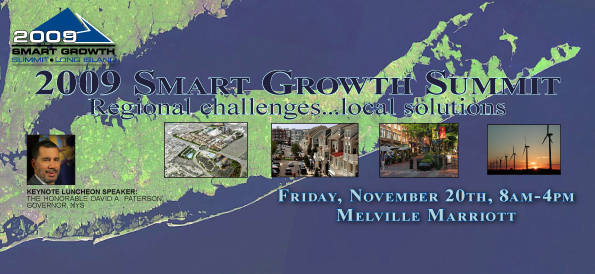
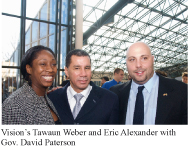

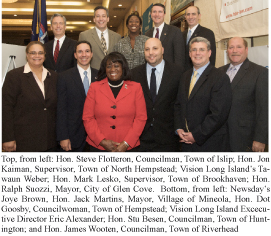 The breakfast plenary session included a large panel of local elected officials, including Town of Brookhaven Supervisor Mark Lesko, Town of North Hempstead Supervisor Jon Kaiman, City of Glen Cove Mayor Ralph Suozzi, Town of Hempstead Councilwoman Dorothy Goosby, Town of Islip Councilman Steven J. Flotteron, Town of Huntington Councilman Stuart Besen, Town of Riverhead Councilman James Wooten, and Village of Mineola Mayor Jack Martins.
The breakfast plenary session included a large panel of local elected officials, including Town of Brookhaven Supervisor Mark Lesko, Town of North Hempstead Supervisor Jon Kaiman, City of Glen Cove Mayor Ralph Suozzi, Town of Hempstead Councilwoman Dorothy Goosby, Town of Islip Councilman Steven J. Flotteron, Town of Huntington Councilman Stuart Besen, Town of Riverhead Councilman James Wooten, and Village of Mineola Mayor Jack Martins. 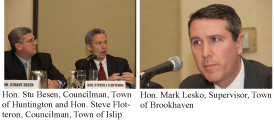
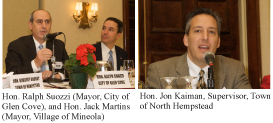
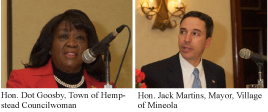
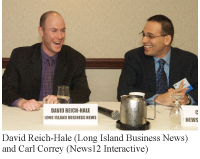 In order to use the news media effectively, we must acknowledge and adapt to the fact that things are changing drastically in today’s market. There are fewer and smaller daily papers as a growing number of people look to the Internet for their information. This mass exodus away from newspapers and TV is happening so quickly that news sources are struggling to keep up. Frequent efforts to stay current include new website layouts, creating and revoking subscriber fees, and changing the frequency of information dissemination. People are also looking at multiple media sources to confirm stories and get difference perspectives. Self-published information is becoming more and more prominent on the Internet. Social media venues such as Facebook, Twitter, YouTube, email lists, and company websites are increasingly being used for advocacy and marketing. These tools allow individuals to manipulate both the content and reach of the message, providing an enormous opportunity to spread a targeted message.
In order to use the news media effectively, we must acknowledge and adapt to the fact that things are changing drastically in today’s market. There are fewer and smaller daily papers as a growing number of people look to the Internet for their information. This mass exodus away from newspapers and TV is happening so quickly that news sources are struggling to keep up. Frequent efforts to stay current include new website layouts, creating and revoking subscriber fees, and changing the frequency of information dissemination. People are also looking at multiple media sources to confirm stories and get difference perspectives. Self-published information is becoming more and more prominent on the Internet. Social media venues such as Facebook, Twitter, YouTube, email lists, and company websites are increasingly being used for advocacy and marketing. These tools allow individuals to manipulate both the content and reach of the message, providing an enormous opportunity to spread a targeted message.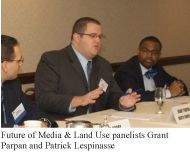 Participants in this workshop discussed how best to use the new media to communicate Smart Growth messages and get the public properly informed on projects. By understanding how the new media landscape functions and how communities relate to it, there is opportunity to ease rather than complicate the approval process. David Reich-Hale of Long Island Business News covers real estate, zoning issues, the residential market, and youth affordability in his writing. Carl Corry of News12 Interactive looks at development and affordable housing issues, and wants to get more involved in how land use plays into Long Island. Grant Parpan of the North Shore Sun mentioned that small papers such as his cover land use and development issues well. Patrick Lespinasse of Verizon said that land use issues impact customers and they would like to be informed (hence the new Verizon News). Some thoughts included the importance of knowing your reporters and how to contact them, plus the importance of attending civic meetings and being involved in the community. Corry said “we look for personal connection and how it changes the region.” Social media was also covered as a great way to connect with the community.
Participants in this workshop discussed how best to use the new media to communicate Smart Growth messages and get the public properly informed on projects. By understanding how the new media landscape functions and how communities relate to it, there is opportunity to ease rather than complicate the approval process. David Reich-Hale of Long Island Business News covers real estate, zoning issues, the residential market, and youth affordability in his writing. Carl Corry of News12 Interactive looks at development and affordable housing issues, and wants to get more involved in how land use plays into Long Island. Grant Parpan of the North Shore Sun mentioned that small papers such as his cover land use and development issues well. Patrick Lespinasse of Verizon said that land use issues impact customers and they would like to be informed (hence the new Verizon News). Some thoughts included the importance of knowing your reporters and how to contact them, plus the importance of attending civic meetings and being involved in the community. Corry said “we look for personal connection and how it changes the region.” Social media was also covered as a great way to connect with the community.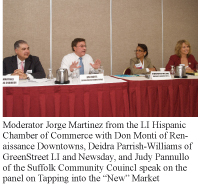 Long Island must adapt to demographic changes by providing market-based solutions. Young people are leaving Long Island at an alarming rate, citing the lack of affordable housing and various social and cultural causes. Long Island trains some of the smartest young minds in the country, but we have yet to find a way to retain them. This is a serious threat to the economic sustainability of Long Island. There are specific needs and desires for the “Millennial” generation, or Gen X, which are not currently found here. Meanwhile, the senior population on the Island is growing as baby boomers age. This group also has specific needs, including smaller, manageable, safe housing. In addition, the immigrant community is growing. They are no longer invisible and we must face certain realities: illegal housing, workers’ rights, health care, and cultural understanding, among other things. The housing and job markets, as well as land use priorities, must respond to the current demographic changes and simultaneously work to attract more young people. Downtown revitalization offers a solution to all of these difficult demographic challenges.
Long Island must adapt to demographic changes by providing market-based solutions. Young people are leaving Long Island at an alarming rate, citing the lack of affordable housing and various social and cultural causes. Long Island trains some of the smartest young minds in the country, but we have yet to find a way to retain them. This is a serious threat to the economic sustainability of Long Island. There are specific needs and desires for the “Millennial” generation, or Gen X, which are not currently found here. Meanwhile, the senior population on the Island is growing as baby boomers age. This group also has specific needs, including smaller, manageable, safe housing. In addition, the immigrant community is growing. They are no longer invisible and we must face certain realities: illegal housing, workers’ rights, health care, and cultural understanding, among other things. The housing and job markets, as well as land use priorities, must respond to the current demographic changes and simultaneously work to attract more young people. Downtown revitalization offers a solution to all of these difficult demographic challenges. 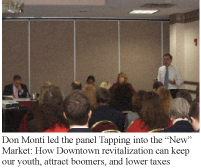 Renaissance Downtowns’ Don Monti said that the US population has grown by 50% over the last 40 years, while Long Island’s has actually decreased by 5%. 65% of LI’s workforce between 18 and 34 is expected to be lost over the next 35 years. 50% of LI’s market includes boomers and Millenials who want to live in walkable downtowns. Speaking of stimulus opportunities, Monti said, “Change is an opportunity to do things better.” Deidre Parrish-Williams of GreenStreet LI said that solutions are not as neatly executed as they can be with a challenge stemming from insular attitudes. LI is how it is because it just works for some people, but not everyone, and to get over this will be a huge challenge. Judy Pannullo of Suffolk Community Council said we must look at inter-generational living, with more families living together in the same home. We must also address ways to make homes more accessible to keep people in homes and out of nursing homes. Other themes in the panel, which was moderated by LI Hispanic Chamber’s Jorge Martinez, included addressing an increasing amount of Latinos, more grassroots efforts to reach out to these demographics, and more inclusive planning.
Renaissance Downtowns’ Don Monti said that the US population has grown by 50% over the last 40 years, while Long Island’s has actually decreased by 5%. 65% of LI’s workforce between 18 and 34 is expected to be lost over the next 35 years. 50% of LI’s market includes boomers and Millenials who want to live in walkable downtowns. Speaking of stimulus opportunities, Monti said, “Change is an opportunity to do things better.” Deidre Parrish-Williams of GreenStreet LI said that solutions are not as neatly executed as they can be with a challenge stemming from insular attitudes. LI is how it is because it just works for some people, but not everyone, and to get over this will be a huge challenge. Judy Pannullo of Suffolk Community Council said we must look at inter-generational living, with more families living together in the same home. We must also address ways to make homes more accessible to keep people in homes and out of nursing homes. Other themes in the panel, which was moderated by LI Hispanic Chamber’s Jorge Martinez, included addressing an increasing amount of Latinos, more grassroots efforts to reach out to these demographics, and more inclusive planning.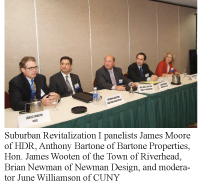 The first session was moderated by CUNY Professor and co-author of Retrofitting Suburbia June Williamson. Riverhead Town Councilman James Wooten discussed Smart Growth progress in downtown Riverhead. Revitalization is beginning to take shape on the semi ghost town feel of Main Street, which came about partly due to the development of big box retail stores on CR 58. In Farmingdale, a Hilton Hotel by Bartone Properties is looking to be the first LEED certified hotel on Long Island. Anthony Bartone explained how they are trying to maintain a pedestrian-friendly environment that connects the street to the train station, promoting walkability. Other panelists included James Moore of HDR and Brian Newman of Newman Design, who discussed their various projects throughout the Island.
The first session was moderated by CUNY Professor and co-author of Retrofitting Suburbia June Williamson. Riverhead Town Councilman James Wooten discussed Smart Growth progress in downtown Riverhead. Revitalization is beginning to take shape on the semi ghost town feel of Main Street, which came about partly due to the development of big box retail stores on CR 58. In Farmingdale, a Hilton Hotel by Bartone Properties is looking to be the first LEED certified hotel on Long Island. Anthony Bartone explained how they are trying to maintain a pedestrian-friendly environment that connects the street to the train station, promoting walkability. Other panelists included James Moore of HDR and Brian Newman of Newman Design, who discussed their various projects throughout the Island. The second session was moderated by active Congress for the New Urbanism New York chapter member and Gotham Design’s Paddy Steinschneider. The Lake Ronkonkoma Civic Organization’s George Schramm covered his community’s new Land Use Plan. Steven Krieger of Engel Burman discussed the Village of Westbury downtown revitalization and his group’s pioneering efforts to get the proper zoning ordinances to increase density. A representative from Tritec mentioned the “brain drain” brought on by lack of jobs, lack of revitalization, and the high cost of housing. Rick Cisterna of Hazen and Sawyer discussed sustainable water resources, introducing to many the idea of Long Island recycling water through reclaimed sources.
The second session was moderated by active Congress for the New Urbanism New York chapter member and Gotham Design’s Paddy Steinschneider. The Lake Ronkonkoma Civic Organization’s George Schramm covered his community’s new Land Use Plan. Steven Krieger of Engel Burman discussed the Village of Westbury downtown revitalization and his group’s pioneering efforts to get the proper zoning ordinances to increase density. A representative from Tritec mentioned the “brain drain” brought on by lack of jobs, lack of revitalization, and the high cost of housing. Rick Cisterna of Hazen and Sawyer discussed sustainable water resources, introducing to many the idea of Long Island recycling water through reclaimed sources. 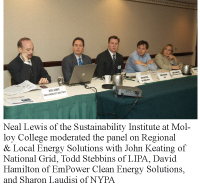 Clean, renewable, alternative energy is something that has been spoken about for a long time on Long Island; however, we have yet to see action on a large scale. The time is now to bring real change to the energy landscape of Long Island in order to help alleviate our reliance on expensive and environmentally damaging fossil fuels. Alternative energy offers various new technologies to choose from for a home or business owner who wants to go green, including wind, solar, fuel cells, and geothermal. With various federal, state, and utility rebates and incentives available, the cost of implementing these technologies is greatly reduced. Alternative energy is something that many want to be a part of, however there has not been a strong enough commitment from local government to help push for the change. The nation has witnessed the success of various solar and wind projects; it is time to bring that success to Long Island. This workshop introduced key figures who help to advance clean energy initiatives and educate communities on the regional advantages of implementing alternative energy.
Clean, renewable, alternative energy is something that has been spoken about for a long time on Long Island; however, we have yet to see action on a large scale. The time is now to bring real change to the energy landscape of Long Island in order to help alleviate our reliance on expensive and environmentally damaging fossil fuels. Alternative energy offers various new technologies to choose from for a home or business owner who wants to go green, including wind, solar, fuel cells, and geothermal. With various federal, state, and utility rebates and incentives available, the cost of implementing these technologies is greatly reduced. Alternative energy is something that many want to be a part of, however there has not been a strong enough commitment from local government to help push for the change. The nation has witnessed the success of various solar and wind projects; it is time to bring that success to Long Island. This workshop introduced key figures who help to advance clean energy initiatives and educate communities on the regional advantages of implementing alternative energy.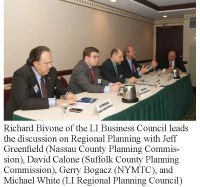 Regional planning is an approach that attempts to combine local interests with a broader perspective. It deals with the efficient placement of land use activities, infrastructure, and population growth across a large land area, addressing issues such as preservation of open space, transportation alternatives, sustainability, zoning changes, and affordable housing. Currently, Long Island is in the midst of various regional plans. In Nassau County, there is a Master Plan in the works for a “New Suburbia,” which emphasizes the enhancement of “Cool Downtowns.” Suffolk County is also in the process of redoing its decades-old master plan. The New York Metropolitan Transportation Council (NYMTC) is funding the Long Island Sustainability Plan and the Regional Planning Council’s Long Island 2035, which are interconnected documents that plan for the future of growth on Long Island. NYMTC is also the lead agency for the regional 2010-2035 Regional Transportation Plan, which establishes a long-term vision for the metropolitan region’s transportation network. Coordinating all of these plans all at once can be overwhelming. This workshop addressed the goals and themes of these plans, their differences and similarities, and how they interact to shape a stronger future for Long Island.
Regional planning is an approach that attempts to combine local interests with a broader perspective. It deals with the efficient placement of land use activities, infrastructure, and population growth across a large land area, addressing issues such as preservation of open space, transportation alternatives, sustainability, zoning changes, and affordable housing. Currently, Long Island is in the midst of various regional plans. In Nassau County, there is a Master Plan in the works for a “New Suburbia,” which emphasizes the enhancement of “Cool Downtowns.” Suffolk County is also in the process of redoing its decades-old master plan. The New York Metropolitan Transportation Council (NYMTC) is funding the Long Island Sustainability Plan and the Regional Planning Council’s Long Island 2035, which are interconnected documents that plan for the future of growth on Long Island. NYMTC is also the lead agency for the regional 2010-2035 Regional Transportation Plan, which establishes a long-term vision for the metropolitan region’s transportation network. Coordinating all of these plans all at once can be overwhelming. This workshop addressed the goals and themes of these plans, their differences and similarities, and how they interact to shape a stronger future for Long Island. 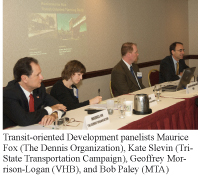 Transit-oriented development, or TOD, is an innovative transportation planning concept that has begun taking hold in many planning circles. TOD is a type of compact, walkable downtown center that is focused around high quality mass transit, such as trains, light rail, trolleys, or buses. By focusing development around transit, communities can become dynamic and exciting places to live, work, and play. TOD is not a new concept. Much of Long Island was initially built to be around a train station, which is why many walkable downtowns exist today. This also contributes to the Long Island Rail Road being the largest commuter rail system in the country today. Communities that grew around LIRR stations are lucky. They have the fabric in place to grow successfully as vibrant downtowns. However, those that have no service or limited service have additional challenges. Long Island must focus on expanding and enhancing LIRR service, especially on the East End where there are few trains each day. The fact is that TOD goes hand in hand with more compact development: communities need certain densities in order to support transit. LIRR service will expand once there is more demand, and demand will come from denser development.
Transit-oriented development, or TOD, is an innovative transportation planning concept that has begun taking hold in many planning circles. TOD is a type of compact, walkable downtown center that is focused around high quality mass transit, such as trains, light rail, trolleys, or buses. By focusing development around transit, communities can become dynamic and exciting places to live, work, and play. TOD is not a new concept. Much of Long Island was initially built to be around a train station, which is why many walkable downtowns exist today. This also contributes to the Long Island Rail Road being the largest commuter rail system in the country today. Communities that grew around LIRR stations are lucky. They have the fabric in place to grow successfully as vibrant downtowns. However, those that have no service or limited service have additional challenges. Long Island must focus on expanding and enhancing LIRR service, especially on the East End where there are few trains each day. The fact is that TOD goes hand in hand with more compact development: communities need certain densities in order to support transit. LIRR service will expand once there is more demand, and demand will come from denser development.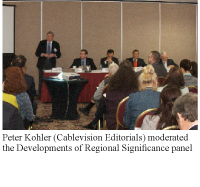 Since the creation of modern-day suburbia, Long Island has never seen the number of large-scale project proposals in public discussion as in this past year. The Lighthouse at Long Island has been tied up in a very public, very political, process. A Request for Proposals finally went out for the Nassau Hub in August. Heartland Town Center moved forward, getting significant input from Town of Islip and other agencies. Glen Isle has been a landmark project, with the developers listening to the public and beginning to put the infrastructure in place to build the waterfront development. East Side Access and other major regional transit investments received federal aid to accelerate construction. Brookhaven National Laboratory recently received federal stimulus funding to construct a massive energy research facility. Not all of these projects are approved, but each carries significant weight in planning for Long Island’s future. Many are based on Smart Growth principles, including a mixture of uses, compact and affordable housing, mass transit integration, vibrant public space, and sustainable energy systems.
Since the creation of modern-day suburbia, Long Island has never seen the number of large-scale project proposals in public discussion as in this past year. The Lighthouse at Long Island has been tied up in a very public, very political, process. A Request for Proposals finally went out for the Nassau Hub in August. Heartland Town Center moved forward, getting significant input from Town of Islip and other agencies. Glen Isle has been a landmark project, with the developers listening to the public and beginning to put the infrastructure in place to build the waterfront development. East Side Access and other major regional transit investments received federal aid to accelerate construction. Brookhaven National Laboratory recently received federal stimulus funding to construct a massive energy research facility. Not all of these projects are approved, but each carries significant weight in planning for Long Island’s future. Many are based on Smart Growth principles, including a mixture of uses, compact and affordable housing, mass transit integration, vibrant public space, and sustainable energy systems.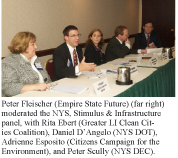 Long Island, like much of the rest of the country, has infrastructure needs that are critical to our economic stability. Crumbling roads in local communities make downtowns less attractive and functional. Enhanced public transportation takes cars off the road, thus lowering congestion and reducing carbon emissions. Sewer infrastructure is probably the largest area where Long Island can benefit, with 70% of Suffolk County unsewered and Nassau systems in need of upgrade. Regional transit investments will also bring major benefits to the Island. All of these components bring our communities into a state of good repair while improving local and regional economies. The American Recovery and Reinvestment Act of 2009 (ARRA) is a $787 billion investment in our struggling infrastructure, schools, energy research, and more. These investments would simultaneously improve our nation’s quality of life and get the jobless back to work. Municipalities and agencies were encouraged to submit their “shovel-ready projects” to their State government, who would be responsible for administering the funds. New York State is expected to receive $26.7 billion over the next several years, to be managed through a new State Economic Recovery and Reinvestment Cabinet. Long Island will receive about $154 million for infrastructure projects. There has been extensive speculation on whether Long Island is receiving its fair share of funding through ARRA, which was a primary focus of this panel.
Long Island, like much of the rest of the country, has infrastructure needs that are critical to our economic stability. Crumbling roads in local communities make downtowns less attractive and functional. Enhanced public transportation takes cars off the road, thus lowering congestion and reducing carbon emissions. Sewer infrastructure is probably the largest area where Long Island can benefit, with 70% of Suffolk County unsewered and Nassau systems in need of upgrade. Regional transit investments will also bring major benefits to the Island. All of these components bring our communities into a state of good repair while improving local and regional economies. The American Recovery and Reinvestment Act of 2009 (ARRA) is a $787 billion investment in our struggling infrastructure, schools, energy research, and more. These investments would simultaneously improve our nation’s quality of life and get the jobless back to work. Municipalities and agencies were encouraged to submit their “shovel-ready projects” to their State government, who would be responsible for administering the funds. New York State is expected to receive $26.7 billion over the next several years, to be managed through a new State Economic Recovery and Reinvestment Cabinet. Long Island will receive about $154 million for infrastructure projects. There has been extensive speculation on whether Long Island is receiving its fair share of funding through ARRA, which was a primary focus of this panel. 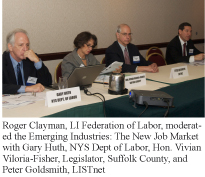 The economic recession has meant record unemployment rates in the US. Long Island was not spared. Recent numbers have been as high as 9.8% unemployment nationally and 7.4% on Long Island. Certain fields have been hit harder than others, such as construction and other private sector industries. Out of the recession, however, new jobs and industries are emerging. The federal stimulus sought to provide immediate temporary construction-related jobs and in many cases, new permanent jobs. However, the recession will not end by public works projects and bank bailouts alone. The market has to change, and evidence already suggests that it is. Several emerging industries are gaining prominence on Long Island. The most apparent is the green movement’s recent influence on energy and development. Green technologies are growing in popularity, from solar panels on rooftops to small-scale wind to better building insulation and climate management systems. Creative sectors to develop such technologies are growing. As these jobs become available, Long Island must question whether its workforce is properly trained for them. This workshop reviewed the emerging industries in Long Island and new workforce needs.
The economic recession has meant record unemployment rates in the US. Long Island was not spared. Recent numbers have been as high as 9.8% unemployment nationally and 7.4% on Long Island. Certain fields have been hit harder than others, such as construction and other private sector industries. Out of the recession, however, new jobs and industries are emerging. The federal stimulus sought to provide immediate temporary construction-related jobs and in many cases, new permanent jobs. However, the recession will not end by public works projects and bank bailouts alone. The market has to change, and evidence already suggests that it is. Several emerging industries are gaining prominence on Long Island. The most apparent is the green movement’s recent influence on energy and development. Green technologies are growing in popularity, from solar panels on rooftops to small-scale wind to better building insulation and climate management systems. Creative sectors to develop such technologies are growing. As these jobs become available, Long Island must question whether its workforce is properly trained for them. This workshop reviewed the emerging industries in Long Island and new workforce needs. 
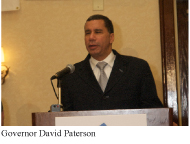 Alexander introduced the Governor by saying “this Governor is taking the lead on Smart Growth in a way that past New York Governors have not." Governor David A. Paterson delivered a positive message on the importance of Smart Growth, saying that “Smart Growth is the idea of addressing the progress of the future rather than the comfort of the present.” Governor Paterson highlighted the Smart Growth Cabinet, which is making sure that state funding supports Smart Growth projects. He also covered the potential of Nassau County as a hub of activity (specifically supporting the Lighthouse project), plus local benefits of mixed use development with open space preservation and contextual planning for the future. He also mentioned revitalization efforts along Route 347 and in downtown Wyandanch. “Smart Growth has to be more than a concept. It has to be a protocol in government,” he said. Governor Paterson really understood the Smart Growth message, concluding that “the future is only ours if we plan for it.”
Alexander introduced the Governor by saying “this Governor is taking the lead on Smart Growth in a way that past New York Governors have not." Governor David A. Paterson delivered a positive message on the importance of Smart Growth, saying that “Smart Growth is the idea of addressing the progress of the future rather than the comfort of the present.” Governor Paterson highlighted the Smart Growth Cabinet, which is making sure that state funding supports Smart Growth projects. He also covered the potential of Nassau County as a hub of activity (specifically supporting the Lighthouse project), plus local benefits of mixed use development with open space preservation and contextual planning for the future. He also mentioned revitalization efforts along Route 347 and in downtown Wyandanch. “Smart Growth has to be more than a concept. It has to be a protocol in government,” he said. Governor Paterson really understood the Smart Growth message, concluding that “the future is only ours if we plan for it.”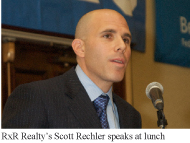 RXR’s Scott Rechler laid out the economic challenges of Long Island, providing a somewhat less positive message than the Governor. “We experienced some extreme trauma” with the economy, he began. Though statistically some say it is over, the recession is still going strong. Rechler predicted it getting worse before it gets better. The recession mentality, possibly more than the recession itself, is tough on jobs, consumers, etc. It seems as though the government is the only group spending money these days. If the government stopped spending, small businesses would drive the economy. We ought to help them! In addition, young people and businesses are leaving Long Island. “We’re not going to be able to compete unless we change,” he said. Rechler also mentioned a great Governor but a dysfunctional State Legislature. Rechler provided three ways to address some of these issues on Long Island: 1) get governments more efficient, including the consolidation of services, 2) ensure that we have leadership that makes sense, and 3) hold our elected officials accountable. In addition, it is important that Long Islanders get out and vote in order to affect real change.
RXR’s Scott Rechler laid out the economic challenges of Long Island, providing a somewhat less positive message than the Governor. “We experienced some extreme trauma” with the economy, he began. Though statistically some say it is over, the recession is still going strong. Rechler predicted it getting worse before it gets better. The recession mentality, possibly more than the recession itself, is tough on jobs, consumers, etc. It seems as though the government is the only group spending money these days. If the government stopped spending, small businesses would drive the economy. We ought to help them! In addition, young people and businesses are leaving Long Island. “We’re not going to be able to compete unless we change,” he said. Rechler also mentioned a great Governor but a dysfunctional State Legislature. Rechler provided three ways to address some of these issues on Long Island: 1) get governments more efficient, including the consolidation of services, 2) ensure that we have leadership that makes sense, and 3) hold our elected officials accountable. In addition, it is important that Long Islanders get out and vote in order to affect real change. 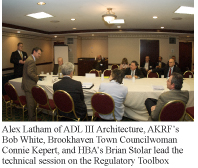 Smart Growth practitioners love their acronyms! Hearing phrases like SEQRA, PDD, and TDR can be daunting at first. This workshop broke down these regulatory tools and reviewed some of their successes and failures in implementation. Often, projects cannot be approved under existing regulations, so it is important to understand these techniques to allow for easy and successful approvals. The panel covered the State Environmental Quality Review Act (SEQRA), Overlay Zones, Planned Development Districts (PDD), Transfer of Development Rights (TDR), Form-based codes including the SmartCode, and more to explore what works and what does not work.
Smart Growth practitioners love their acronyms! Hearing phrases like SEQRA, PDD, and TDR can be daunting at first. This workshop broke down these regulatory tools and reviewed some of their successes and failures in implementation. Often, projects cannot be approved under existing regulations, so it is important to understand these techniques to allow for easy and successful approvals. The panel covered the State Environmental Quality Review Act (SEQRA), Overlay Zones, Planned Development Districts (PDD), Transfer of Development Rights (TDR), Form-based codes including the SmartCode, and more to explore what works and what does not work.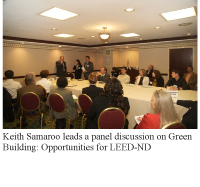
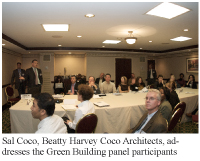
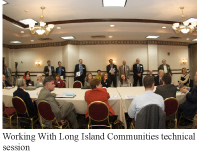 There are various tools and techniques that can be used to successfully work with communities in Long Island. To begin, a charrette is a collaborative session where stakeholders work together to draft a long-range solution to a design problem in a short, intense period of time. At the local level, the charrette has evolved into a visioning process in which participants focus not only on the design and future goals for the community, but also on the implementation tools needed, including local government integration. Visioning meetings require extensive outreach to residents and stakeholders to ensure that every voice is represented. Context is key in working with communities. The result of this care and dedication is a fully supported community-based plan, which can then easily be adopted into Town or Village code. In addition to visionings, project implementation often legally requires a public review process. Community involvement can also come in the form of organized coalitions to support or reject a proposal, focus groups, participation in local master plans, and more.
There are various tools and techniques that can be used to successfully work with communities in Long Island. To begin, a charrette is a collaborative session where stakeholders work together to draft a long-range solution to a design problem in a short, intense period of time. At the local level, the charrette has evolved into a visioning process in which participants focus not only on the design and future goals for the community, but also on the implementation tools needed, including local government integration. Visioning meetings require extensive outreach to residents and stakeholders to ensure that every voice is represented. Context is key in working with communities. The result of this care and dedication is a fully supported community-based plan, which can then easily be adopted into Town or Village code. In addition to visionings, project implementation often legally requires a public review process. Community involvement can also come in the form of organized coalitions to support or reject a proposal, focus groups, participation in local master plans, and more. 
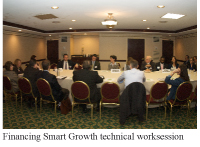
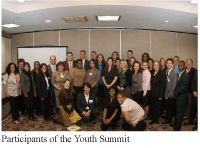 The Youth Summit grew to 50 students this year, representing various local colleges and universities. The passionate students came together to learn about social, economic, energy, and environmental issues facing Long Island and to propose informed solutions to these issues. The students worked together with experts in four workshops: (1) suburban planning, suburban culture, and Smart Growth; (2) local governance and civic participation in suburban development; (3) renewable energy, environmental preservation and suburban development; and (4) social and economic inequality in suburbia. At the end of the Summit, the students presented their proposals in the form of policy recommendations to be implemented by the current and future Long Island leaders. The students left the Summit energized to make change in their local communities.
The Youth Summit grew to 50 students this year, representing various local colleges and universities. The passionate students came together to learn about social, economic, energy, and environmental issues facing Long Island and to propose informed solutions to these issues. The students worked together with experts in four workshops: (1) suburban planning, suburban culture, and Smart Growth; (2) local governance and civic participation in suburban development; (3) renewable energy, environmental preservation and suburban development; and (4) social and economic inequality in suburbia. At the end of the Summit, the students presented their proposals in the form of policy recommendations to be implemented by the current and future Long Island leaders. The students left the Summit energized to make change in their local communities.